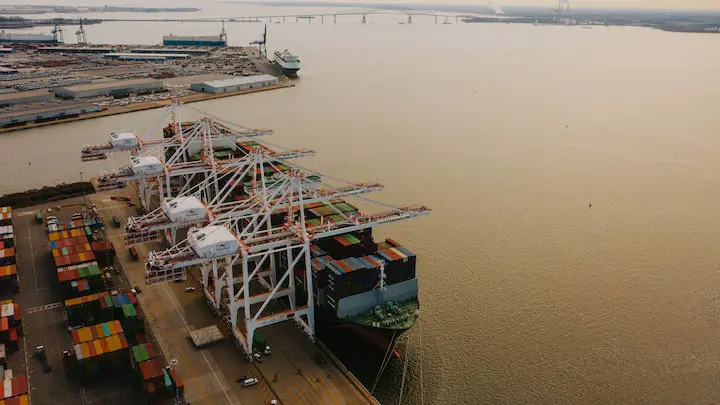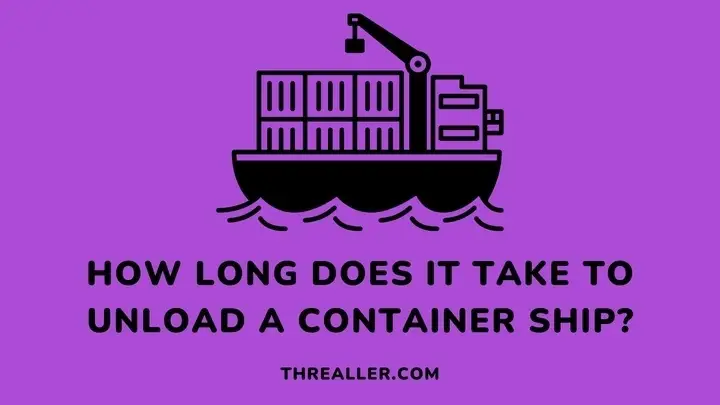Container ships are crucial in transporting goods across vast distances and countries. How long it takes to unload them depends on the size of the ship and the port’s efficiency.
On average, unloading a container ship takes 2 to 3 days. Besides, unloading these massive vessels efficiently is essential for prompt last-mile or final delivery to customers.
This guide explains how long it takes to unload a container ship, the equipment required, and the processes involved. You will also learn about the factors that can delay the process and strategies that can enhance efficiency.
How Long Does It Take To Unload a Container Ship?
The duration of unloading a container ship can vary significantly. It usually depends on the ship’s size, the number of containers, the weight and content of the cargo, the equipment available, and workflow.
The entire procedure should only last about 2 to 3 days for medium-sized container ships, provided there is a constant workflow and under optimal conditions. This process may last for a week or more for larger vessels.
Equipment You Need to Unload a Container Ship
- Cranes: are responsible for lifting containers from ships and placing them in trucks or railway platforms. Specialized cranes such as ship-to-shore (STS), gantry, or mobile harbor cranes are commonly used.
- Forklifts and straddle carriers: Help transport containers within the port area, especially from the cranes to the storage area.
- Terminal tractors or yard trucks: transport containers over long distances within the port or to a nearby warehouse. Trailers are attached to these tractors to facilitate container transportation.
How to Unload a Shipping Container

There are 2 major ways port authorities unload a container ship: from a raised position or the ground. The content or weight of the containers usually determines the method to employ.
Before commencing the process, necessary safety precautions must be established. They include securing the work area, placing appropriate signage in the right areas, and providing gadgets such as helmets, safety vests, and gloves.
Once safety precautions are established, the process can begin via any of these methods:
1. Unloading from a raised container
This method involves unloading from a container that is still mounted on the chassis of a truck. It is used to unload containers with regular or palletized cargo. You can empty the contents of such a container by hand or a pallet trolley.
2. Unloading from the ground
Unloading a container holding very large or heavy cargo from a raised position is not advisable. Such a container must first be placed at ground level with the help of a crane, reach cracker and heavy-duty forklift.
Once the container is at ground level, a regular forklift or mobile yard ramp can unload it.
Factors That Can Delay Unloading
1. Weather conditions
Adverse weather conditions, such as heavy rain, strong wind, or storms, can significantly impede unloading. This is especially true for cranes that may be limited in their operations due to safety concerns.
2. Customs and inspection procedures
Customs clearance and inspection are vital to ensuring compliance with regulations and security measures. Delays may occur due to a backlog or unexpected complications during this process.
3. Congestion and logistics
Congestion within the port and logistical challenges such as lack of labor and equipment can contribute to the slow pace of unloading.
Strategies to Optimize Unloading Efficiency
1. Streamlined planning and documentation
Efficient planning and documentation on the part of the port and retailers can minimize administrative and unloading delays.
Adopting electronic systems and advanced software for cargo tracking, customs clearance, and documentation is one way to streamline these operations.
2. Adopting advanced technology
Aside from improving paperwork processes and tracking, unloading should be executed with the latest equipment, like remote-controlled cranes. These upgrades increase speed and efficiency.
3. Improved port infrastructure and layout
Port infrastructure and design for storage yards and dockside areas will facilitate smoother container movement and reduce congestion.
FAQs
What is a full container load?
A full container load (FCL) is a shipment that contains cargo owned by one person or company. The opposite is less than container load (LCL) – a container with cargo from multiple shippers.
Can you unload a shipping container sideways?
This is possible for containers with doors fitted at the side. However, such containers are not standard and may require speaking to your supplier to get one or special equipment to unload them.
How many containers can a ship carry?
Currently, large ships transport up to 18,000 to 20,000 TEU or more.
Wrapping Up
Unloading a container ship requires skilled coordination, specialized equipment, and efficient port operations. The entire procedure can last from a few hours to weeks, depending on different factors.
With this understanding, stakeholders in the shipping industry can easily decide where they need to optimize their operations. Buyers will also recognize the significance of efficient unloading and how it affects delivery speed.
I hope you found this guide helpful. Kindly explore Threaller for more shipping guides.
Thanks for reading.
